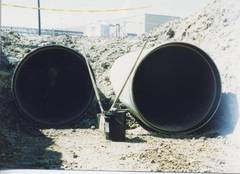Case Histories > Industrial > Pulp and Paper Effluent Line
Hobas Valuable In Paper Mill
High strength, corrosion resistant Hobas fiberglass pipes were installed in Pennington, Alabama to transport acidic effluent (pH of 3 to 4) created in operations at the pulp and paper mill. The piping material chosen had to meet the very demanding conditions present including low pH, elevated temperatures (average operating of 90 to 100 degrees with excursions to 140 degrees F) and shallow cover depths with surface traffic. The Hobas fiberglass pipe was buried with only 1 foot of cover through frequently saturated, very soft, native materials.
Easy Installation
The 48-inch diameter pipes have a pipe stiffness of 72 psi and are constructed with an isophthalic polyester structural resin and a vinyl ester liner resin. The pipes, supplied primarily in 20 ft. sections, were field connected with Hobas FWC couplings. The parallel effluent lines run over 500 feet and terminate at a fiberglass-lined manhole structure in which Hobas FWC couplings were laminated into the fiberglass wall of the manhole liner. The Hobas FWC coupling is a structural filament-wound sleeve which is over-wrapped and mechanically locked to an internal full-face EPDM elastomeric gasket. This allows the coupling to maintain a leak-free seal, pipe to pipe, with easy push-together assembly. The quick and secure field connections with the FWC joint pleased both the installation contractor and the plant engineers. The Hobas installation was the first for the paper mill and the installation contractor. Although, the contractor admits that initially they were a little apprehensive about installing a “fiberglass” pipe, they were happy to find that Hobas pipe is much stronger, tougher and installation friendly than they anticipated.
The 48-inch diameter pipes have a pipe stiffness of 72 psi and are constructed with an isophthalic polyester structural resin and a vinyl ester liner resin. The pipes, supplied primarily in 20 ft. sections, were field connected with Hobas FWC couplings. The parallel effluent lines run over 500 feet and terminate at a fiberglass-lined manhole structure in which Hobas FWC couplings were laminated into the fiberglass wall of the manhole liner. The Hobas FWC coupling is a structural filament-wound sleeve which is over-wrapped and mechanically locked to an internal full-face EPDM elastomeric gasket. This allows the coupling to maintain a leak-free seal, pipe to pipe, with easy push-together assembly. The quick and secure field connections with the FWC joint pleased both the installation contractor and the plant engineers. The Hobas installation was the first for the paper mill and the installation contractor. Although, the contractor admits that initially they were a little apprehensive about installing a “fiberglass” pipe, they were happy to find that Hobas pipe is much stronger, tougher and installation friendly than they anticipated.
Material of Choice
Hobas pipes were chosen due to the need for a high strength piping material which was also able to meet the corrosion resistance needs of the project. Other piping materials which were reviewed included high density polyethylene and concrete. The HDPE did not provide adequate strength for this type of installation due to the presence of vehicle traffic. Areas currently exist throughout the plant where HDPE has been installed previously which are now restricted from vehicle traffic, since the HDPE piping material cannot handle the surface loads at such low cover depths. This has proven to be very inconvenient. The concrete pipe can be designed with adequate strength to meet the loading conditions, however, it is not suitable for such an aggressive environment. Hobas was the only material that met all of the engineers’ criteria. With the project complete and the pipe now on line, all parties are happy with the installation and their decision to choose Hobas. They are confident that Hobas will meet the test of time.
Hobas pipes were chosen due to the need for a high strength piping material which was also able to meet the corrosion resistance needs of the project. Other piping materials which were reviewed included high density polyethylene and concrete. The HDPE did not provide adequate strength for this type of installation due to the presence of vehicle traffic. Areas currently exist throughout the plant where HDPE has been installed previously which are now restricted from vehicle traffic, since the HDPE piping material cannot handle the surface loads at such low cover depths. This has proven to be very inconvenient. The concrete pipe can be designed with adequate strength to meet the loading conditions, however, it is not suitable for such an aggressive environment. Hobas was the only material that met all of the engineers’ criteria. With the project complete and the pipe now on line, all parties are happy with the installation and their decision to choose Hobas. They are confident that Hobas will meet the test of time.

